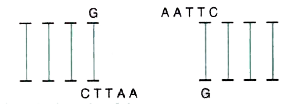An intersting property of restriction enzymes is molecular cutting and past-ing. Restriction enzymes typically recognize a symmetrical sequence of DNA .

Notice that the top strand is the same as the bottom strand, but reads backward . When the enzyme cuts the strand between G and A, it leaves over-hanging chains

a. What is this symmetrical sequence of DNA known as ?
b. What is the significance of these overhanging chains ?
c. Name the restriction enzyme that cuts the strand between G and A. Solution in Tamil
a. This symmetrical sequence of DNA is known as .palindromic se-quence .
b. These overhanging chains have sticky ends and they can be easily joined by DNA ligase.
c. Restriction endonuclease from E.coli strain (Eco RI)
Topper's Solved these Questions
- BIOTECHNOLOGY : PRINCIPLES AND PROCESSES BOOK - NEW JOYTHI PUBLICATIONCHAPTER - BIOTECHNOLOGY : PRINCIPLES AND PROCESSES EXERCISE - Previous Entrance Exam Corner
6 Videos
- BIODIVERSITY AND CONSERVATION BOOK - NEW JOYTHI PUBLICATIONCHAPTER - BIODIVERSITY AND CONSERVATION EXERCISE - PREVIOUS YEAR COMPETITIVE EXAM QUESTIONS
17 Videos
- BIOTECHNOLOGY AND ITS APPLICATIONSBOOK - NEW JOYTHI PUBLICATIONCHAPTER - BIOTECHNOLOGY AND ITS APPLICATIONSEXERCISE - CONTINUOUS EVALUATION
3 Videos
Similar Questions
A restriction enzyme called ECORI from E. coli is expected to cleave DNA at the following sequence .
View SolutionWhich of these is an in-situ method of conservation?
View SolutionWhat a plant tissue culture lab and prepare a report of basic requirements of a tissure culture lab.
View SolutionAssertion : Restriction enzymes recongise palindromic sequences.
Reason : Palindromic sequences read same in both directions of the two strand.
View SolutionAssertion : Restriction enzymes cut the strand of DNA to produce sticky ends.
Reason : Stickness of the ends facilitates the action of the enzyme DNA polymerase
View SolutionAssertion : Restriction enzymes cut the strand of DNA a little away from the centre of the palindromic sites Reason: Restriction enzymes cut the strads of DNA between the same two bases on the opposite strand.
View SolutionAssetion: Restriction enzymes cut the strand 27 of DNA to produce sticky ends
Reason : Stickiness of the ends faciliates the action of the enzyme DNA polymerase
View SolutionRestriction endonuclease ( EcoRI) enzyme cut the strand of DNA
View SolutionAn interesting property of restriction enzymes is molecular cutting and pasting. Restriction enzymes typically recognize a symmetrical sequence of DNA.

Notice that the top strand is the same as the bottom strand, but reads backward. When the enzyme cuts the strand between G and A, it leaves overhanging chains:

A. What is this symmetrical sequence of DNA known as?
B. What is the significance of these overhanging chains?
C. Name the restriction enzyme that cuts the strand between G and A.
View Solutionकौनसा एन्जाइम जो DNA डुप्लेक्स के एक स्ट्रैण्ड को काट कर दो स्ट्रेण्ड के कुण्डलन के तनाव को मुक्त करने में सहायता करता है
View SolutionAssertion : Restriction enzymes recongise palindromic sequences.
Reason : Palindromic sequences read same in both directions of the two strand.
View SolutionWhich of the following sequences along a double stranded DNA may be recognized as a cutting site for a particular restriction enzyme.
View SolutionAn interesting property of restriction enzymes is molecular cutting. Restriction enzymes typically recognise a symmetrical sequence of DNA.

Notice that the top strand is the same as the bottom strand, but reads backward. When the enzyme cuts the strand between G and A, it leaves overhanging chains :

(a) What is this symmetrical sequence of DNA known as?
(b) What is the significance of these overhanging chains?
(c) Name the restriction enzyme that cuts the strand between G and A.
View SolutionWho discovered that restriction enzymes have the capability of cutting DNA strands in a particular fashion, which left what has became known as 'sticky ends' on the strands ?
View SolutionRestriction endonuclease ( EcoRI) enzyme cut the strand of DNA
View Solution
